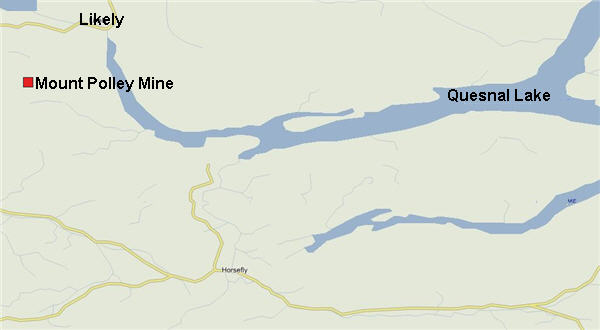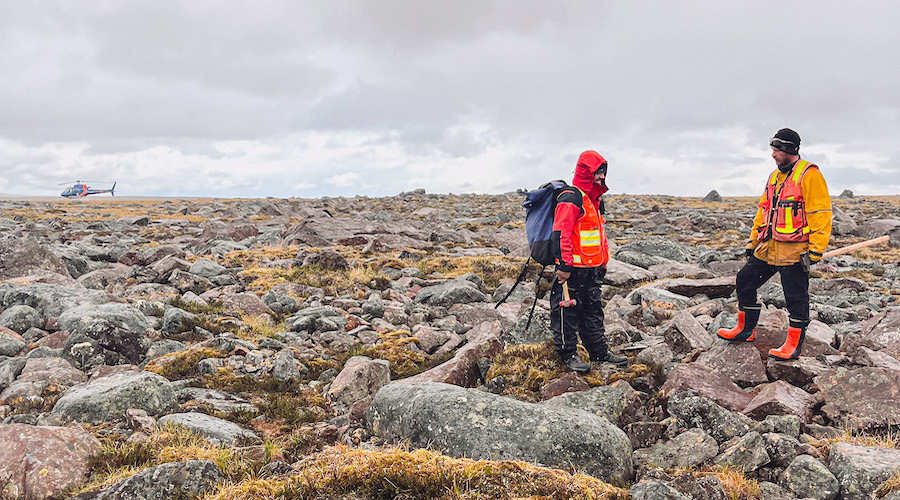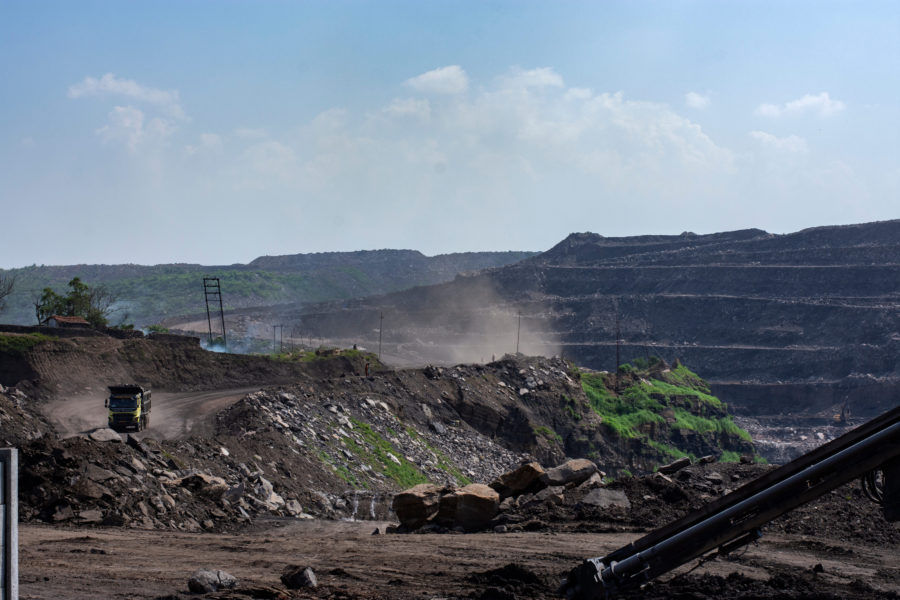Eyewitnesses, Twitterverse and BC mines minister on the Polley Mountain tailings breach

Image from Caiboo Regional District
Two boaters on the east arm of Quesnel Lake told the Williams Lake Tribune what they saw after turning their boat back to Lively, BC. They were unaware that the Mount Polley tailings dam gave way during the night. Stan and Rosanne Siemens of Quesnel were surprised at seeing a floating mass of twisted trees in the lake.
“It’s rude up there,” Stan Siemens says. “Half way across the lake trees were sticking straight up. I’m a logger and it would take us a year to take that many trees down, and this happened in 20 minutes.”

Map from InfoMine
Meanwhile a reporter dropped by Imperial Metals’ Vancouver office and took a picture of what he saw:
Imperial Metals office locked; a press release taped to the door about the Mt Polley mine incident @CTVVancouver pic.twitter.com/P9RAlhhORU
— Jon Woodward (@ctv_jon) August 5, 2014
Global BC put the spill into perspective:
Mount Polley tailings spill: What 5 million cubic metres looks like #likelyBC http://t.co/oypu0UlMUr
— Global BC (@GlobalBC) August 5, 2014
Bill Bennett, Minister of Energy and Mines, responded to Mt. Polley Mine Incident:
VICTORIA – Minister of Energy and Mines Bill Bennett made the following statement today in response to the mine tailing pond incident at Mt. Polley Mine:
“In the early morning of August 4, 2014, the tailings pond dam at the Mt. Polley Mine site breached and released an estimated 10 million cubic metres of water and 4.5 million cubic metres of fine sand into Polley Lake. Hazeltine Creek flows out of Polley Lake, and the flow may have continued into Quesnel Lake.
“This is a serious incident that should not have happened. We are devoting every appropriate resource working with local officials to clean up the site, mitigate any impacts to communities and the environment, and investigate the cause of the breach. We will determine the cause of the event and we are determined to prevent an incident like this from happening again.
“RCMP, Mt. Polley Mine executives, Ministry of Energy and Mines, Ministry of Environment, Emergency Management BC, Ministry of Transportation, Cariboo Regional District, Search and Rescue and Cariboo Dam Safety, responded to the event. Any potential environmental impact from the tailings pond water on the local watershed is unknown at this time but all efforts are being made to make a determination as soon as possible.
“Cariboo Regional District, in consultation with Interior Health, has issued a precautionary water ban advisory not to drink or bathe in the water and not to allow pets or livestock to drink the water. The waterways affected by the ban include Quesnel Lake, Polley Lake, Hazeltine Creek and Cariboo Creek, as well as the Quesnel and Cariboo Rivers systems up to the Fraser River.
The ban does not apply to people in Williams Lake or other towns along the Fraser River.
“The Ministry of Environment is on-site conducting water tests to determine the full extent of potential environmental impacts. Water sampling took place the evening of Aug 4. Samples have been sent for analysis today, with results expected later this week.
“Ministry of Energy and Mines Inspectors are at the mine site investigating the cause.
“Cariboo Regional District has set up a public information line at 250-398-5581, and updates will be posted to the Cariboo Regional District’s emergency operations Facebook page.
“As more information becomes available, the B.C. government will provide that information to British Columbians.”
New Democrat Leader John Horgan released a statement following the incident:
“This breach has the potential to have a devastating effect on people, livestock and wild animals in the region for many years to come. My thoughts are with everyone who is working to understand what happened, stop continued damage and begin to remediate as best as possible what can only be described as a disastrous failure of mine infrastructure.
“Responsible resource development needs to be a priority for B.C. We all know that permitting industrial activity has an environmental impact that needs to be balanced against the economic benefits locally, regionally and provincially. This incident demonstrates how critical that balance is and what happens when you get it wrong.
“It’s worrying that the B.C. Liberal government took over a day even to comment. It raises concerns about whether the government has the ability to monitor the safety of these structures or is able to effectively respond to incidents when they happen.
“The coming days will shed more light on what went wrong at this tailings pond. New Democrats will be among those looking for answers.”
DISCLOSURE: The reporter Michael McCrae is an investor in Imperial Metals.
More News
Gates, Bezos-backed critical minerals explorer to ‘go big’ on Congo – report
April 27, 2025 | 08:27 am
{{ commodity.name }}
{{ post.title }}
{{ post.date }}



6 Comments
R. Blakestad
Silt happens! As a mining and minerals exploration person for +40 years, and an avid hunter and fisherman who loves to take family and friends into the natural environment, these events hurt me to the very core of my being.
It is important to remember, and for those who are not geologists – to consider, that the present surface of the earth is but a current manifestation of what used to be there. The surface of Earth is being eroded at an average rate of less than two-hundredths of a millimeter per year. So, an observant person might recognize that in one hundred years of life, two millimeters of land around them has been eroded from the hills and mountains and passed through those beautiful creeks to the ocean.
Over the past one million years, 20,000 millimeters, or 20 meters of land have gone to the ocean. Over 20 million years, a mere 400 meters of the land surface (1,312 feet or a quarter of a mile) has been transported through those very same pristine creeks and rivers to the ocean. When you consider that the rocks exposed at the surface in the area of the incident are more than 60 million years old, it helps to put things into perspective.
Notwithstanding, the persons responsible for this incident should be held accountable for the near-term damage done….
Listen
Imperial Metals is among the worst BC performers in corporate responsibility. So they lock the doors and hide. It’s these types that give mining a bad name.
golddigger69
Blakestad, The issue here is not how fast the earth erodes on average–how ever one wants to try to apply that concept, it doesn’t lead to an understanding of what when wrong here. The sad fact is that this is how most tailing ponds will end up. These structures are too often built with “life of mine” or other short-term design characteristics, when in reality that should hold for perpetuity. A structure such as this will fail, it is only a matter of when (e.g. after the miner has walked away). TSFs need to be designed to a much higher standard than is now required, and if the industry does not do it itself, others will step in and demand it from us.
Matt
No “most” tailings ponds will not end up this way. However you are right about the perpetuity thing and more has to be done at the treatment end of the equation to make it so the ponds can divulge the clean water and leave behind solid toxins that naturally occur. It will not be easy.
Oiseaux
Blakestad AKA Imperial metals CEO !!
Alex Nichols
This is tragic but can it be seen as an opportunity for the company and its peers to learn from and improve its practices, de-risk sustainability related risks, learn how to do stakeholder engagement and see the value of it, improve governance arrangements (and not repeat BP et al’s post-Macondo mistakes), apply the principles of “sustainability/CSR management” (or ‘good, wider risk management’) such as inclusivity, materiality, and responsiveness (lovely jargon for you)? Having worked with a number of extractives companies in my 20 year sustainability consulting career so far I know there are some expert people working on this stuff in variety of companies, and who know that it works.
And let’s recall Mark Cutifani’s WMC speech recently about how the industry is poor at telling its story, and how it’s time to improve on innovation and engagement.(http://www.ceecthefuture.org/wp-content/uploads/2013/09/mark-cutifani-speech-at-WMC.pdf)?
Alex
Alex Nichols Consulting Ltd +44(0) 7811 946084